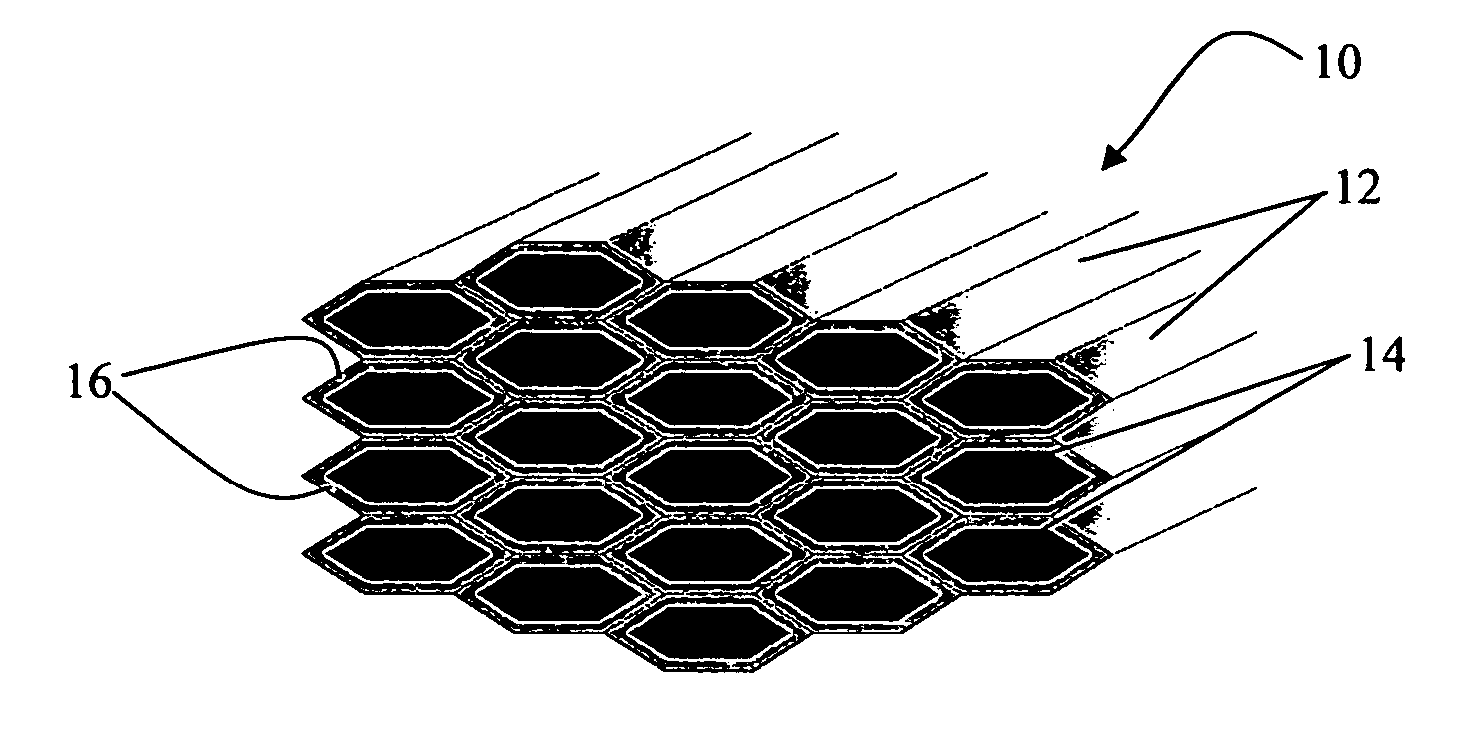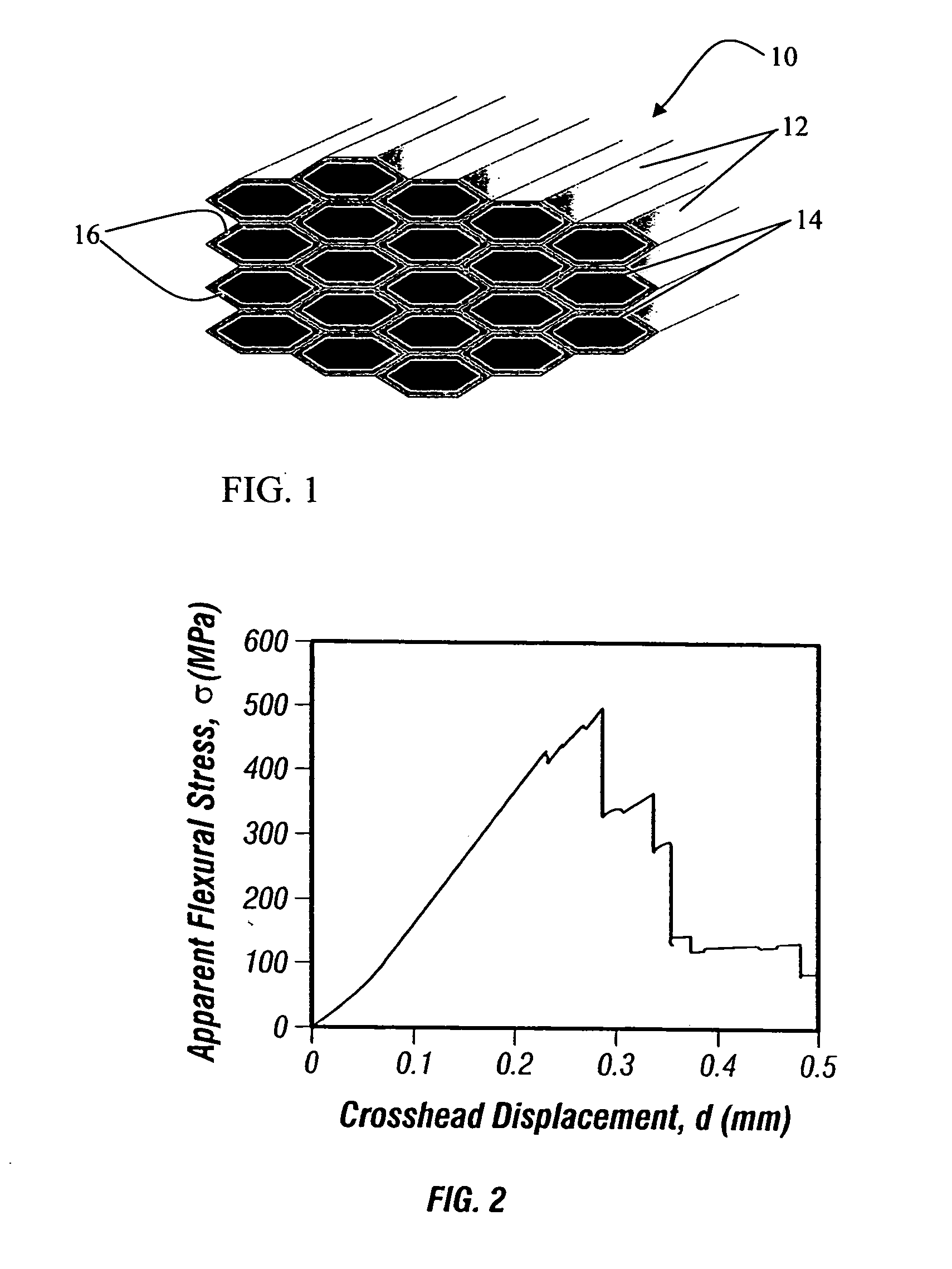Aligned composite structures for mitigation of impact damage and resistance to wear in dynamic environments
a composite structure and dynamic environment technology, applied in the field of fibrous monolith composites, can solve the problems of unpredicted, catastrophic failure, controlled failure of the structure, etc., and achieve the effects of increasing flaw insensitivity, increasing wear resistance, and improving mechanical properties
- Summary
- Abstract
- Description
- Claims
- Application Information
AI Technical Summary
Benefits of technology
Problems solved by technology
Method used
Image
Examples
example 1
[0078] The thermoplastic / powder blends are produced in batches and are formulated on a volumetric basis. One blend includes between about 50 to about 62 vol. % of ceramic powder, between about 37 to about 50 vol. % of thermoplastics, and between about 0 to about 12 vol. % of plasticizers. The mass of a batch of ceramic / thermoplastic dope varies with the density of the ceramic powder. A batch of Si3N4 has a density of about 3.44 g / cc and produces approximately 1 kg of “green” compound material.
example 2
[0079] Initial damage resistant testing was conducted on a FM composite consisting of a cellular diamond material surrounded by a ductile metal phase of WC—Co (FIG. 4a). Impact drop tests demonstrated that the FM composite remained undamaged at much higher drop heights as compared to a standard monolithic diamond material.
example 3
[0080] Composites having unique architectures were produced by fabricating Si3N4 / BN FM layers and hot pressing the layers into different Si3N4-based substrates. Three different sets of Si3N4 were fabricated for testing. The three billets fabricated were: 1) a Si3N4 / BN FM layer on a monolithic Si3N4 substrate, 2) a Si3N4 / BN FM layer on a unidirectional Si3N4 / BN FM substrate, and 3) a Si3N4 / BN FM layer on a quasiisotropic Si3N4 / BN FM substrate.
[0081] These samples were fabricated using a two-step process. First, the Si3N4 / BN FM layer was produced. Specifically, a unidirectional Si3N4 / BN billet (3″×4.5″×0.5″) was laminated using multiple, extruded Si3N4 / BN filaments. The individual cell size was approximately 200 μm. Thin 0.12 inch FM layers were produced by sectioning the billet into thin 0.12 inch slices along its width to expose the cells. Each 0.12 inch slice constituted a FM layer.
[0082] Second, the monolithic, uniaxial, and quasiisotropic FM substrates were processed. For the m...
PUM
| Property | Measurement | Unit |
|---|---|---|
| thicknesses | aaaaa | aaaaa |
| thicknesses | aaaaa | aaaaa |
| temperatures | aaaaa | aaaaa |
Abstract
Description
Claims
Application Information
 Login to View More
Login to View More - R&D
- Intellectual Property
- Life Sciences
- Materials
- Tech Scout
- Unparalleled Data Quality
- Higher Quality Content
- 60% Fewer Hallucinations
Browse by: Latest US Patents, China's latest patents, Technical Efficacy Thesaurus, Application Domain, Technology Topic, Popular Technical Reports.
© 2025 PatSnap. All rights reserved.Legal|Privacy policy|Modern Slavery Act Transparency Statement|Sitemap|About US| Contact US: help@patsnap.com



